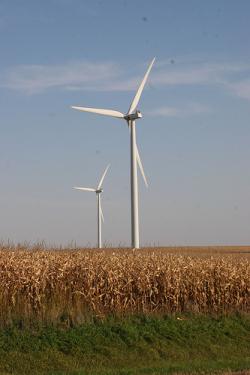In this episode of Local Energy Rules, ILSR’s Director of Democratic Energy, John Farrell, speaks to Brian Minish, CEO of South Dakota Wind Partners about a community wind project that attracted over 600 local investors. The project was the brainchild of four state organizations rooted in rural South Dakota–the East River Electric Cooperative, South Dakota Farm Bureau, South Dakota Farmers Union and South Dakota Corn Growers. Hoping to broaden ownership in a wind farm project proposed by Basin Electric in Crow Lake, these groups worked with Brian to figure out how to add local investors to the mix.
Podcast (Local Energy Rules): Play in new window | Download | Embed
The project took shape in the shadow of Basin Electric‘s proposed wind farm near Crow Lake, with local farmers and other South Dakotans interested in taking part in the wind project. The result was a community-based carve out of the 100+ megawatt facility: 7 turbines owned by over 600 farmers and local residents. The turbines were constructed as part of the larger wind farm, and the Wind Partners organization contracted with the cooperative electric utility for operations, maintenance, and purchase of the electricity.
Brian Minish helped structure the offer to investors, using the now-expired federal cash grant (in lieu of the Investment Tax Credit) to broaden the opportunity for more local investment. Each of the four organizations kick-started the fundraising with $20,000 and shares were sold in increments of $15,000 to other investors.
As Brian notes during the interview, South Dakota Wind Partners (SDWP) structured the offering in a way that would make the program available to different groups of investors. Some were able to invest as equity partners and share in the tax losses generated in the early years, while others just wanted a fixed return on the debt (basically making a fixed interest loan to the project).
Brian attributes much of his success with SDWP to the willingness of Basin Electric to partner with local groups, making the process easier for everyone involved. He continues to work with a number of groups in different states hoping to replicate the success of SDWP.
Unfortunately, the federal cash grant has since expired, making it more difficult to make investment open to normal investors. In a previous interview, Brian notes that federal renewable energy policy matters a lot for community-based projects like South Dakota Wind Partners. “There’s a lot of political benefit in letting local people become investors in the project,” Minish said, “local ownership can help reduce opposition to wind power projects.”
Brian keeps searching for ways to open up opportunity for community-based energy projects and overcome barriers, and he may be having some success. The SDWP website highlights two other community-based projects, one in New York and one in Texas. It’s a good sign that, despite the challenges, SDWP may be a model for community wind around the country.




